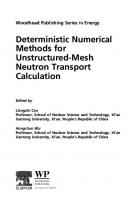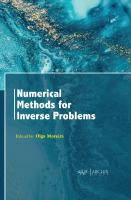Deterministic Numerical Methods for Unstructured-Mesh Neutron Transport Calculation 9780128182215, 0128182210
Deterministic Numerical Methods for Unstructured-Mesh Neutron Transport Calculation presents the latest deterministic nu
202 22 9MB
English Pages 288 [284] Year 2020
Table of contents :
Front-Mat_2021_Deterministic-Numerical-Methods-for-Unstructured-Mesh-Neutron
Front Matter
Copyrig_2021_Deterministic-Numerical-Methods-for-Unstructured-Mesh-Neutron-T
Copyright
Contribut_2021_Deterministic-Numerical-Methods-for-Unstructured-Mesh-Neutron
Contributors
Forewor_2021_Deterministic-Numerical-Methods-for-Unstructured-Mesh-Neutron-T
Foreword
Prefac_2021_Deterministic-Numerical-Methods-for-Unstructured-Mesh-Neutron-Tr
Preface
1---Neutron-transpo_2021_Deterministic-Numerical-Methods-for-Unstructured-Me
Neutron transport equation
Introduction
Definition of the ordinates and basic elements
Coordinate system
Neutron density, angular flux, and current
First-order transport equation
Derivation of the NTE
Different forms of divergence operator
Definite conditions
Second-order transport equation
Second-order even-parity neutron transport equation
Second-order SAAF transport equation
Integral form of transport equation
Brief introduction to the numerical solution to NTE
Eigenvalue problem and source iteration method
Overview of approximate solution for neutron transport equation
The adjoint transport equation
Adjoint operator
Adjoint neutron transport equation
Neutron importance function
References
2---Collision-probab_2021_Deterministic-Numerical-Methods-for-Unstructured-M
Collision probability method
Integral-form neutron transport equation
Collision probability for solving NTE
CPM calculation flowchart
Collision probability evaluation
Collision probability properties
References
3---Transmission-probability-_2021_Deterministic-Numerical-Methods-for-Unstr
Transmission probability method for triangular meshes
Basic equations
Two-dimensional calculation
Approximation
Probability calculation
Leakage probability calculation
Transmission probability calculation
Boundary conditions and unstructured-mesh sweeping
Three-dimensional calculation
Approximation
Probability calculation
Leakage probability calculation
Transmission probability calculation
Boundary conditions and unstructured-mesh sweeping
Numerical results
2D problem
3D problem
References
4---Current-coupled-collis_2021_Deterministic-Numerical-Methods-for-Unstruct
Current-coupled collision probability method
Theory
Introduction
Discretization
The coupling equations
Response matrices
Numerical results
The problems of regular and irregular cells
The 2D C5G7 problem
References
5---The-method-of-ch_2021_Deterministic-Numerical-Methods-for-Unstructured-M
The method of characteristics
Basic equations
Two-dimensional MOC
Long ray tracing technique
Modular ray tracing technique
Three-dimensional MOC
3D modular ray tracing technique
Angular quadrature sets
Geometry pretreatment method
2D/1D fusion method
Basic equations
Potential negative total sources
Traditional leakage splitting method
The improved leakage splitting method
Numerical results
Irregular 2D geometric problem
Single fuel particle problem
C5G7 problem
References
6---PN-FEM-m_2021_Deterministic-Numerical-Methods-for-Unstructured-Mesh-Neut
PN-FEM method
Basic equations
First-order transport equation
Weak formulation from weighted residual method
Discretization of the equation
Angular approximation
Spatial discretization
Boundary conditions
Stabilized finite element method
SUPG method
GLS method
TG method
SGS method
Unified expression of stabilized finite element method
Value of stabilization parameter
Finite element implementation
Evaluation of integrals
Angular integrals
Spatial integrals
Spatial-angular integrals
Evaluation of algebraic equation
LHS matrix
RHS vector
Assemble and solve the equations
Numerical results
1D Analytical problem
1D Reed cell problem
Maynard Watanabe problem
Strong scattering problem
Strong absorption problem
IAEA 5-region fixed source problem
Kobayashi problem 3i
Helium cooling ceramic breeder for fusion DEMO
Typical tritium breeding blanket module of CFETR
Chinese fusion engineering test reactor
Appendix 1. Recurrence relation of spherical harmonics
Appendix 2. Shape function of simplex element
References
7---The-discrete-ord_2021_Deterministic-Numerical-Methods-for-Unstructured-M
The discrete ordinate method
Establishment of basic equations
Establishment of one-dimensional discrete ordinate equation
Establishment of multidimensional discrete ordinate equation
Spatial variable discretization
SN finite element method for unstructured geometry
Least-squares variation
Spatial discretization
Treatment of boundary condition
Solution of the stiffness matrix
Numerical results
SN nodal method for triangular prism meshes
Spatial discretization
Numerical solution process
Selection of the quadrature set
Numerical results
Appendix 1
Appendix 2
Appendix 3
Appendix 4
References
8---Mesh-free-_2021_Deterministic-Numerical-Methods-for-Unstructured-Mesh-Ne
Mesh-free method
Introduction of mesh-free method
Theory of mesh-free method
Support domain
Formulation
Numerical scheme
Numerical procedure and core development
Numerical results
2D2G problem
2D4G problem
2D-IAEA problem
2D-TWIGL problem
4G-LMFBR problem
Natelson problem
Transient localized source problem
Discussions
References
9---Other-me_2021_Deterministic-Numerical-Methods-for-Unstructured-Mesh-Neut
Other methods
Wavelet expansion method in neutron transport
Wavelet basis function
Wavelet expansion method
Numerical results
Heterogeneous variational nodal method
The VNM formulations
The legacy multigroup Guass-Seidel (MG GS) algorithm
The within group red-black Gauss-Seidel (RBGS) algorithm
Hybrid method of Monte Carlo and method of characteristics
The criticality calculation of transport equation
Division of energy ranges
The MOC calculations in the fast and thermal energy ranges
The Monte Carlo simulation in the resonance energy range
The hybrid Monte Carlo deterministic method in energy range
Numerical results
References
Inde_2021_Deterministic-Numerical-Methods-for-Unstructured-Mesh-Neutron-Tran
Index
A
B
C
D
E
F
G
H
I
J
K
L
M
N
O
P
Q
R
S
T
U
V
W
X
Front-Mat_2021_Deterministic-Numerical-Methods-for-Unstructured-Mesh-Neutron
Front Matter
Copyrig_2021_Deterministic-Numerical-Methods-for-Unstructured-Mesh-Neutron-T
Copyright
Contribut_2021_Deterministic-Numerical-Methods-for-Unstructured-Mesh-Neutron
Contributors
Forewor_2021_Deterministic-Numerical-Methods-for-Unstructured-Mesh-Neutron-T
Foreword
Prefac_2021_Deterministic-Numerical-Methods-for-Unstructured-Mesh-Neutron-Tr
Preface
1---Neutron-transpo_2021_Deterministic-Numerical-Methods-for-Unstructured-Me
Neutron transport equation
Introduction
Definition of the ordinates and basic elements
Coordinate system
Neutron density, angular flux, and current
First-order transport equation
Derivation of the NTE
Different forms of divergence operator
Definite conditions
Second-order transport equation
Second-order even-parity neutron transport equation
Second-order SAAF transport equation
Integral form of transport equation
Brief introduction to the numerical solution to NTE
Eigenvalue problem and source iteration method
Overview of approximate solution for neutron transport equation
The adjoint transport equation
Adjoint operator
Adjoint neutron transport equation
Neutron importance function
References
2---Collision-probab_2021_Deterministic-Numerical-Methods-for-Unstructured-M
Collision probability method
Integral-form neutron transport equation
Collision probability for solving NTE
CPM calculation flowchart
Collision probability evaluation
Collision probability properties
References
3---Transmission-probability-_2021_Deterministic-Numerical-Methods-for-Unstr
Transmission probability method for triangular meshes
Basic equations
Two-dimensional calculation
Approximation
Probability calculation
Leakage probability calculation
Transmission probability calculation
Boundary conditions and unstructured-mesh sweeping
Three-dimensional calculation
Approximation
Probability calculation
Leakage probability calculation
Transmission probability calculation
Boundary conditions and unstructured-mesh sweeping
Numerical results
2D problem
3D problem
References
4---Current-coupled-collis_2021_Deterministic-Numerical-Methods-for-Unstruct
Current-coupled collision probability method
Theory
Introduction
Discretization
The coupling equations
Response matrices
Numerical results
The problems of regular and irregular cells
The 2D C5G7 problem
References
5---The-method-of-ch_2021_Deterministic-Numerical-Methods-for-Unstructured-M
The method of characteristics
Basic equations
Two-dimensional MOC
Long ray tracing technique
Modular ray tracing technique
Three-dimensional MOC
3D modular ray tracing technique
Angular quadrature sets
Geometry pretreatment method
2D/1D fusion method
Basic equations
Potential negative total sources
Traditional leakage splitting method
The improved leakage splitting method
Numerical results
Irregular 2D geometric problem
Single fuel particle problem
C5G7 problem
References
6---PN-FEM-m_2021_Deterministic-Numerical-Methods-for-Unstructured-Mesh-Neut
PN-FEM method
Basic equations
First-order transport equation
Weak formulation from weighted residual method
Discretization of the equation
Angular approximation
Spatial discretization
Boundary conditions
Stabilized finite element method
SUPG method
GLS method
TG method
SGS method
Unified expression of stabilized finite element method
Value of stabilization parameter
Finite element implementation
Evaluation of integrals
Angular integrals
Spatial integrals
Spatial-angular integrals
Evaluation of algebraic equation
LHS matrix
RHS vector
Assemble and solve the equations
Numerical results
1D Analytical problem
1D Reed cell problem
Maynard Watanabe problem
Strong scattering problem
Strong absorption problem
IAEA 5-region fixed source problem
Kobayashi problem 3i
Helium cooling ceramic breeder for fusion DEMO
Typical tritium breeding blanket module of CFETR
Chinese fusion engineering test reactor
Appendix 1. Recurrence relation of spherical harmonics
Appendix 2. Shape function of simplex element
References
7---The-discrete-ord_2021_Deterministic-Numerical-Methods-for-Unstructured-M
The discrete ordinate method
Establishment of basic equations
Establishment of one-dimensional discrete ordinate equation
Establishment of multidimensional discrete ordinate equation
Spatial variable discretization
SN finite element method for unstructured geometry
Least-squares variation
Spatial discretization
Treatment of boundary condition
Solution of the stiffness matrix
Numerical results
SN nodal method for triangular prism meshes
Spatial discretization
Numerical solution process
Selection of the quadrature set
Numerical results
Appendix 1
Appendix 2
Appendix 3
Appendix 4
References
8---Mesh-free-_2021_Deterministic-Numerical-Methods-for-Unstructured-Mesh-Ne
Mesh-free method
Introduction of mesh-free method
Theory of mesh-free method
Support domain
Formulation
Numerical scheme
Numerical procedure and core development
Numerical results
2D2G problem
2D4G problem
2D-IAEA problem
2D-TWIGL problem
4G-LMFBR problem
Natelson problem
Transient localized source problem
Discussions
References
9---Other-me_2021_Deterministic-Numerical-Methods-for-Unstructured-Mesh-Neut
Other methods
Wavelet expansion method in neutron transport
Wavelet basis function
Wavelet expansion method
Numerical results
Heterogeneous variational nodal method
The VNM formulations
The legacy multigroup Guass-Seidel (MG GS) algorithm
The within group red-black Gauss-Seidel (RBGS) algorithm
Hybrid method of Monte Carlo and method of characteristics
The criticality calculation of transport equation
Division of energy ranges
The MOC calculations in the fast and thermal energy ranges
The Monte Carlo simulation in the resonance energy range
The hybrid Monte Carlo deterministic method in energy range
Numerical results
References
Inde_2021_Deterministic-Numerical-Methods-for-Unstructured-Mesh-Neutron-Tran
Index
A
B
C
D
E
F
G
H
I
J
K
L
M
N
O
P
Q
R
S
T
U
V
W
X

- Author / Uploaded
- Liangzhi Cao
- Hongchun Wu









